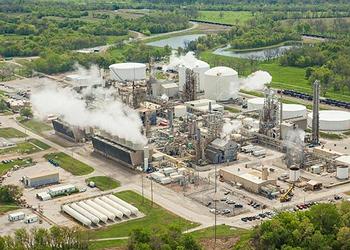
ITHACA, New York, June 6, 2019 (ENS) – Emissions of the potent greenhouse gas methane from the ammonia fertilizer industry have been greatly underestimated, finds new research from Cornell University and the nonprofit Environmental Defense Fund. The methane emissions were higher than the EPA’s estimate for all industrial processes in the United States.
The scientists estimated methane emissions from this important downstream consumer of natural gas, the ammonia fertilizer industry, which uses natural gas as a feedstock and a fuel for the production of ammonia and other upgraded products.

Using a Google Street View car equipped with a high-precision methane sensor, the researchers discovered that methane emissions from ammonia fertilizer plants were 100 times higher than the fertilizer industry’s self-reported estimate.
The methane emissions also were substantially higher than the Environmental Protection Agency’s estimate for all industrial processes in the United States.
“We took one small industry that most people have never heard of and found that its methane emissions were three times higher than the EPA assumed was emitted by all industrial production in the United States,” said John Albertson, co-author and professor of civil and environmental engineering at Cornell.
“It shows us that there’s a huge gap between a priori estimates and real-world measurements,” said Albertson, whose research covers mobile sensing to identify fugitive methane emissions in oil and gas production regions as well as in the fertilizer industry.
The researchers’ findings are reported in “Estimation of Methane Emissions From the U.S. Ammonia Fertilizer Industry Using a Mobile Sensing Approach,” published in the journal “Elementa.”
The use of natural gas has grown in recent years, bolstered by improved efficiency in shale gas extraction and the perception that natural gas is a less dirty fossil fuel than coal, oil, gasoline or diesel.
“But natural gas is largely methane, which molecule-per-molecule has a stronger global warming potential than carbon dioxide,” Albertson said. “The presence of substantial emissions or leaks anywhere along the supply chain could make natural gas a more significant contributor to climate change than previously thought.”
Ammonia fertilizer is produced at just a few dozen plants in the United States. Factories are often located near public roadways, where emissions carried downwind can be detected, in this case by mobile sensors.
“Even though a small percentage is being leaked, the fact that methane is such a powerful greenhouse gas makes the small leaks very important,” said Joseph Rudek, co-author and lead senior scientist at the Environmental Defense Fund. “In a 20-year timeframe, methane’s global warming potential is 84 times that of carbon dioxide.”

For this study, the Google Street View vehicle traveled public roads near six representative fertilizer plants in the country’s midsection to quantify “fugitive methane emissions,” defined as inadvertent losses of methane to the atmosphere.
The emissions were likely due to incomplete chemical reactions during fertilizer production, incomplete fuel combustion or leaks, the researchers explained.
The team discovered that, on average, 0.34 percent of the gas used in the plants is emitted to the atmosphere.
Scaling this emission rate from the six plants to the entire industry suggests total annual methane emissions of 28 gigagrams per year – 100 times higher than the fertilizer industry’s self-reported estimate of 0.2 gigagrams per year.
This figure far exceeds the EPA’s estimate that all industrial processes in the United States produce only eight gigagrams of methane emissions per year.
“Pollution in the air doesn’t respect property boundaries, so even if you don’t have access to private land, the current revolution in sensor technologies allows us a lens into the degree of cleanliness of a factory,” Albertson said.
“With opportunistic sensing, pushing data to the cloud, doing the proper analysis and drawing inferences, we can build environmental policy that is based on evidence,” he said.
The research was funded in part by a grant from the Atkinson Center for a Sustainable Future’s joint research program with the Environmental Defense Fund.
Copyright Environment News Service (ENS) 2019. All rights reserved.
© 2019, Environment News Service. All rights reserved. Content may be quoted only with proper attribution and a direct link to the original article. Full reproduction is prohibited.
